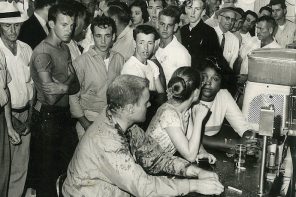For a guy like me who writes a column like this one, professing that science and religion compose a complementary double helix, that inauguration speech was pretty darn good.
Here was a newly sworn-in President Obama, a man of faith, saying in the same speech that he mentions God, faith, and religion no less than six times (and this after Rick Warren’s invocation): “We will restore science to its rightful place, and wield technology’s wonders…”
Here was a walking, talking, free-world-leading example of how one person can view both science and religion as good and powerful forces that can work together for a better world.
Such a complementary, synergistic approach will bring new energy and possibilities to many science and religion-heavy issues like stem-cell research, abortion, homosexuality, and health care. But there is one such issue, which will certainly involve no new laws, around which Obama may have the most impact and the greatest potential legacy: race.
Among scholars, race is one of those words for which each discipline has a definition that they stand staunchly behind—despite the fact that each discipline’s definition is different. Race is part of that great murk of definitions, information, science, culture, religion, and politics that goes into defining who we are.
Maybe the trick, I suggest and I think Obama implies, is to actively integrate different fields and their definitions in order to shape more effective meaning and, in the end, more effective action.
Out in the real world, many don’t think of race as having any relevant biological or religious meaning at all, but the list is long of those who have tried to use the heavy hammers of religious or scientific authority to strengthen or dilute what race means.
Scientists themselves, often behind the exclusive and powerful veil of “the scientific method,” have been explicitly engaged in the race to define race. And I’m not just talking about Josef Mengele and his bizarre and twisted Nazi experiments and the many other scientists who collaborated in treating Jews and others as specific races (Ellis Island listed “Jew” under “race” for early 20th century Jewish immigrants).
Stephen J. Gould and others have exhaustively chronicled how scientists studying human cultures, the first anthropologists, used definitions of different races—as determined by measuring characteristics like skull size and type of hair—to form the foundations of their field.
The infamous Tuskegee Syphilis Study in Alabama, which went on openly for decades, researching if the natural history of syphilis is the same in blacks and whites (letting the disease go untreated in black men even after the advent of penicillin) only received an official apology from the American government in the 1990s. Herrnstein and Murray’s 1994 book The Bell Curve, claiming that different races have different IQs and that this has important implications for social policy, is one of the more recent contributions to the long, and often ugly, history of science and race.
These days, the conversation tends to be more subtle in science which balances the race question on a slippery paradox: on the one hand, scientists claim that race is entirely a social construct and has no biologic underpinnings whatsoever; on the other, in just the last 5 years, over 10,000 articles have been published in biomedical journals examining the role race plays in disease and other biological phenomena. The first race-specific drug, BiDil (for heart disease in black men), is currently on the market.
But if there is no such thing as race, how do researchers and physicians select and define black or white or Latino for their studies? Since Jews are no longer considered a race, but presumably only a religion, how is this relevant to genetic studies, medical prescriptions? And how are these questions relevant to what makes any of us who we are?
Perhaps the most striking example of this blurry question of race within science, with all its implications for society and culture and vice versa, is the effort to catalog the gene sequences of humans—the ease with which you can send cheek cells (containing DNA) off to various internet-accessible companies who then tell you that you’re 23% African or 15% Turkish or both. What do these percentages mean as numbers, much less socioculturally? And what if one gene version occurs more frequently in those calling themselves “black” or “white”? And what if this gene is involved somehow in a complex behavior? Or, as has already happened, what if someone who calls him- or herself black has no “official” African genes?
Could an integrated engagement of the religious and scientific communities help answer these questions and give race richer meaning? Or even better, wouldn’t it be something if our new president—as a walking, talking, free-world-leading complementary double helix of the two previously distinct worldviews—were able to make the definition of race moot, if his greatest legacy were a quantum leap toward the dream another man articulated 46 years ago:
I have a dream that one day every valley shall be exalted, every hill and mountain shall be made low, the rough places will be made plain, and the crooked places will be made straight, and the glory of the Lord shall be revealed, and all flesh shall see it together.



